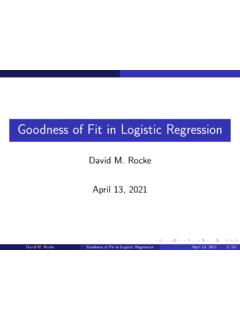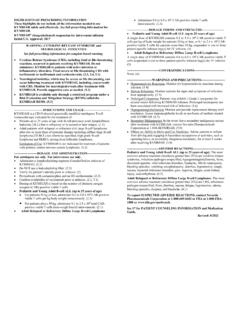Transcription of The Cox Proportional Hazards Model
1 The Cox Proportional Hazards ModelDavid M. RockeMay 4, 2021 David M. RockeThe Cox Proportional Hazards ModelMay 4, 20211 / 30 Bone Marrow Transplant DataCopelan et al. (1991) study of allogeneic (from adonor) bone marrow transplant therapy for acutemyeloid leukemia (AML) and acute lymphoblasticleukemia (ALL).Possible intermediate events are graft vs. hostdisease (GVHD), an immunological rejectionresponse to the transplant, and platelet recovery, areturn of platelet count to normal levels. One or theother, both in either order, or neither may point events are relapse of the disease or or all of these events may be M.
2 RockeThe Cox Proportional Hazards ModelMay 4, 20212 / 30 KMsurv bmt dataThe bmt data frame has 137 rows and 22 data frame contains the following columns:group Disease Group 1-ALL, 2-AML Low Risk, 3-AML High Riskt1 Time To Death Or On Study Timet2 Disease Free Survival Time (Time To Relapse, Death, Or End Of Study)d1 Death Indicator 1-Dead 0-Alived2 Relapse Indicator 1-Relapsed, 0-Disease Freed3 Disease Free Survival Indicator 1-Dead Or Relapsed, 0-Alive Disease Free)ta Time To Acute graft -Versus-Host Diseaseda Acute GVHD Indicator 1-Developed Acute GVHD 0-Never Developed Acute GVHD)
3 Tc Time To Chronic graft -Versus-Host Diseasedc Chronic GVHD Indicator 1-Developed Chronic GVHD0-Never Developed Chronic GVHDtp Time To Platelet Recoverydp Platelet Recovery Indicator 1-Platelets Returned To Normal,0-Platelets Never Returned to NormalDavid M. RockeThe Cox Proportional Hazards ModelMay 4, 20213 / 30 KMsurv bmt dataz1 Patient Age In Yearsz2 Donor Age In Yearsz3 Patient Sex: 1-Male, 0-Femalez4 Donor Sex: 1-Male, 0-Femalez5 Patient CMV Status: 1-CMV Positive, 0-CMV Negativez6 Donor CMV Status: 1-CMV Positive, 0-CMV Negativez7 Waiting Time to Transplant In Daysz8 FAB: 1-FAB Grade 4 Or 5 and AML, 0-Otherwisez9 Hospital: 1-The Ohio State University, 2-Alferd , 3-St.
4 Vincent,4-Hahnemannz10 MTX Used as a graft -Versus-Host- Prophylactic: 1-Yes 0-NoDavid M. RockeThe Cox Proportional Hazards ModelMay 4, 20214 / 30 Bone Marrow Transplant ExampleWe concentrate for now on disease-free survival (t2andd3) for the three risk groups, ALL, AML LowRisk, and AML High will construct the Kaplan-Meier survival curves,compare them, and test for will construct the cumulative hazard curves andcompare will estimate the hazard functions, interpret,and compare we will introduce the Cox Proportional M. RockeThe Cox Proportional Hazards ModelMay 4, 20215 / 30 Survival Function S(t) = ti<t[1 di/Yi]whereYiis the group at risk at estimated variance of S(t) is (Greenwood s formula) V[ S(t)] = S(t)2 ti<tdiYi(Yi di)which we can use for confidence intervals for a survivalfunction or a difference of survival M.
5 RockeThe Cox Proportional Hazards ModelMay 4, 20216 / 30To see where Greenwood s formula comes from, letxi=Yi di. We approximate the solution treating eachtime as independent, withYifixed and ignorerandomness in times of failure and we treatxiasindependent binomialsBin(Yi,pi). LettingS(t) be the true survival function S(t) = ti<txi/YiS(t) = ti<tpiDavid M. RockeThe Cox Proportional Hazards ModelMay 4, 20217 / 30 S(t)S(t)= ti<txipiYi= ti<t pipi= ti<t(1 + pi pipi) 1 + ti<t pi pipiDavid M. RockeThe Cox Proportional Hazards ModelMay 4, 20218 / 30 Var( S(t)S(t)) Var(1 + ti<t pi pipi)= ti<t1p2ipi(1 pi)Yi= ti<t(1 pi)piYi ti<t(1 xi/Yi)xi= ti<tYi xixiYi= ti<tdiYi(Yi di)Var( S(t)) S(t)2 ti<tdiYi(Yi di)David M.
6 RockeThe Cox Proportional Hazards ModelMay 4, 20219 / 30 Cumulative Hazardh(t) = dlnS(t)dtThe cumulative hazard function isH(t) = t0h(t)dt= lnS(t) H(t) = ln S(t)David M. RockeThe Cox Proportional Hazards ModelMay 4, 202110 / 30> library(KMsurv)> library(survival)> data(bmt)> dfsurv <- Surv(bmt$t2,bmt$d3)> plot(survfit(dfsurv~group,data=bmt),col= 1:3,lwd=2)> title("Disease-Free Survival for Three Groups")> legend("bottomright",c("ALL","Low Risk AML","High Risk AML"),col=1:3,lwd=2)> plot(survfit(dfsurv~group,data=bmt),col= 1:3,lwd=2,fun="cumhaz")> title("Disease-Free Cumulative Hazard for Three Groups")> legend("bottomright",c("ALL","Low Risk AML","High Risk AML"),col=1.)
7 3,lwd=2)> survdiff(dfsurv~group,data=bmt)N Observed Expected (O-E)^2/E (O-E)^2/Vgroup=1 38 24 54 25 45 34 on 2 degrees of freedom, p= that group is treated as a factor even though it is is the Mantel-Haenszel M. RockeThe Cox Proportional Hazards ModelMay 4, 202111 / Free Survival for Three GroupsALLLow Risk AMLHigh Risk AMLD avid M. RockeThe Cox Proportional Hazards ModelMay 4, 202112 / Free Cumulative Hazard for Three GroupsALLLow Risk AMLHigh Risk AMLD avid M. RockeThe Cox Proportional Hazards ModelMay 4, 202113 / 30 Nelson-Aalen Survival Function EstimateThe point hazard at timetican be estimated bydi/Yiwhich leads to the estimate of the cumulative hazard H(t) = ti<tdi/Yiwhich has approximate variance V[ H(t)] = ti<t(di/Yi)(1 di/Yi)Yi ti<tdiY2igiving an alternate estimate of the survival function SNA(t) = exp[ H(t)]David M.
8 RockeThe Cox Proportional Hazards ModelMay 4, 202114 / 30 The product limit estimate and the Nelson-Aalenestimate often do not differ by much. The latter isconsidered more accurate in small samples and alsodirectly estimates the cumulative hazard. The"fleming-harrington"method reduces toNelson-Aalen when the data are unweighted. We canalso estimate the cumulative hazard as the negative logof the KM survival function <- survfit(dfsurv~group,type="fleming-harri ngton",data=bmt)plot(survfit(dfsurv~grou p,data=bmt))lines(nafit,col=2)legend("bo ttomleft",c("Product Limit","Nelson-Aalen"),col=1:2,lwd=1)tit le("Two Survival Function Estimates for Three Groups")David M.
9 RockeThe Cox Proportional Hazards ModelMay 4, 202115 / LimitNelson AalenTwo Survival Function Estimates for Three GroupsDavid M. RockeThe Cox Proportional Hazards ModelMay 4, 202116 / 30 Nelson-Aalen Survival Function EstimateThe Nelson-Aalen estimate of the cumulative hazard isusually used for estimates of the hazard and often thecumulative the Hazards of the three groups are Proportional , thatmeans that the ratio of the Hazards is constant can test this using the ratios of the estimatedcumulative Hazards , which also would be M. RockeThe Cox Proportional Hazards ModelMay 4, 202117 / 30nafit <- survfit(dfsurv~group,type="fleming-harri ngton",data=bmt)timevec <- 1.
10 1000sf1 <- stepfun(nafit[1]$time,c(1,nafit[1]$surv) )sf2 <- stepfun(nafit[2]$time,c(1,nafit[2]$surv) )sf3 <- stepfun(nafit[3]$time,c(1,nafit[3]$surv) )cumhaz1 <- -log(sf1(timevec))cumhaz2 <- -log(sf2(timevec))cumhaz3 <- -log(sf3(timevec))plot(timevec,cumhaz1/c umhaz2,type="l",ylab="Hazard Ratio",xlab="Time",ylim=c(0,6))lines(tim evec,cumhaz3/cumhaz1,ylab="Hazard Ratio",xlab="Time",col=2)lines(timevec,c umhaz3/cumhaz2,ylab="Hazard Ratio",xlab="Time",col=3)legend("bottomr ight",c("1/2","3/1","3/2"),col=1:3,lwd=1 )title("Hazard Ratios for Three Groups")David M. RockeThe Cox Proportional Hazards ModelMay 4, 202118 / 30020040060080010000123456 TimeHazard Ratio1/23/13/2 Hazard Ratios for Three GroupsDavid M.





